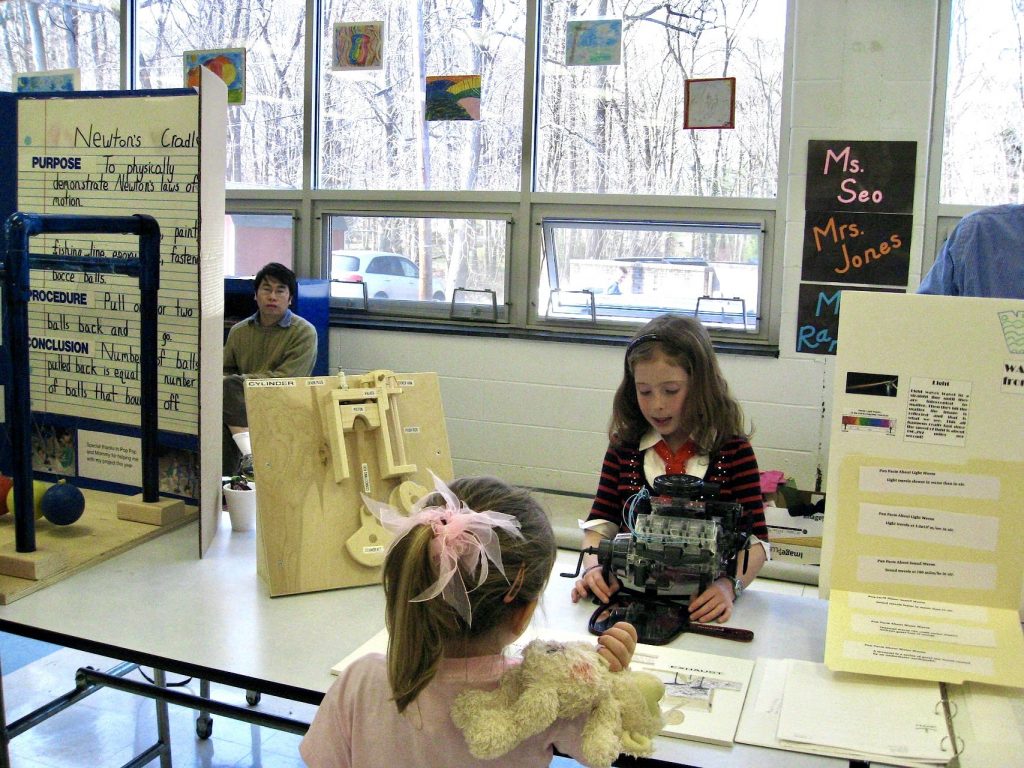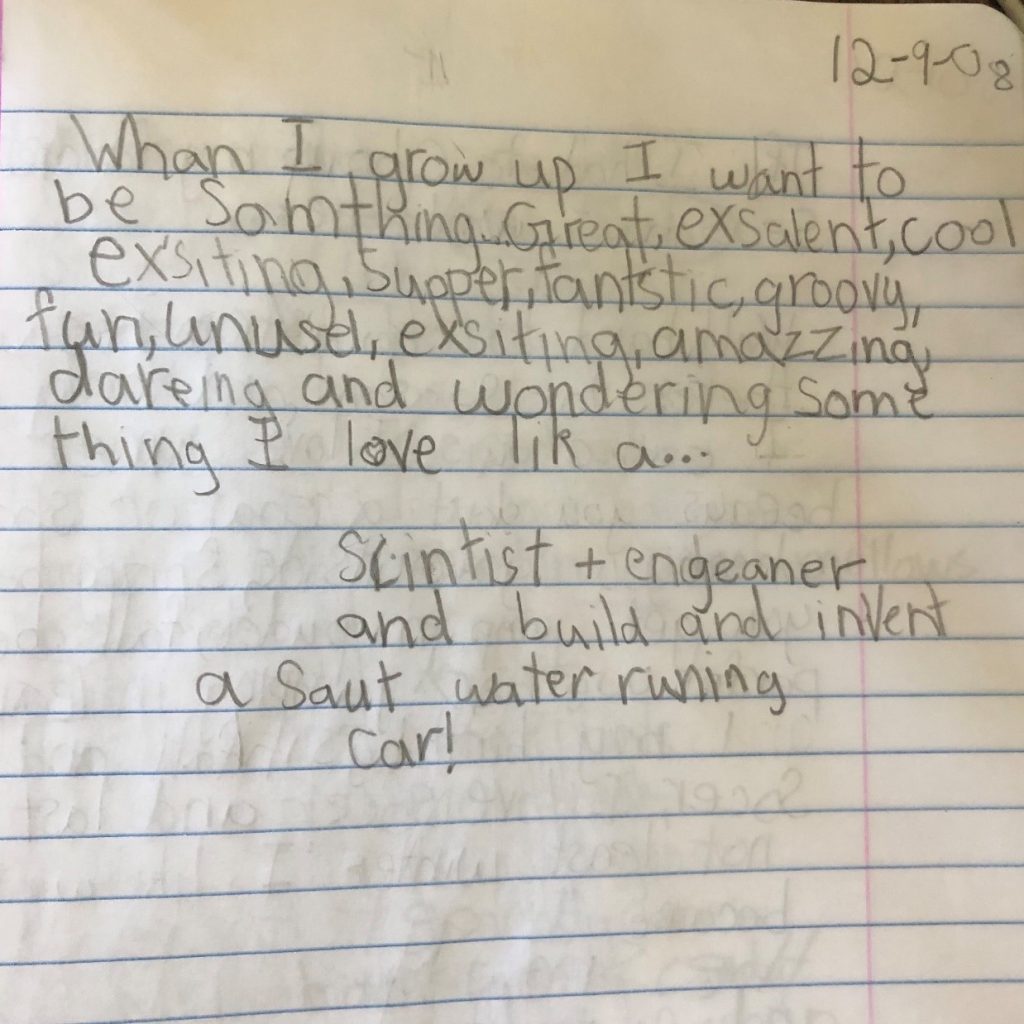If you asked my eight-year-old self what I wanted to be when I grew up, the answer would have been, resoundingly, “an inventor!” It was around this time that I also decided, with surprising assuredness for a shy second grader, that I would one day build a saltwater-powered car.
I must have heard the idea somewhere, although to this day I don’t quite recall where. Perhaps it was a story on the radio. NPR was a constant background noise in the basement where I spent countless hours playing and tinkering alongside my father in his hobby shop. Or maybe it was buried somewhere in a book or science magazine. They were often stacked in neat piles, filling bookcases in many corners of our house. It also could have floated across the dinner table in conversations between my parents and older siblings. Everyday talk of high school biology and current events seemed light years out of the grasp of my eight-year-old brain.

Regardless of where it came from, the idea stuck. Before I knew what it meant to conduct research or study engineering, I found myself charmed by novel ideas and drawn to the possibility of discovery. For some reason, this “car that runs on salt water” took shelter in my mind and secured itself as the perfect idea: an ingenious invention that was good for the planet. At the time, of course, I never thought about how this whimsical, far-fetched idea was fundamentally tied to my core interests and values. Now, however, as a 21-year-old senior studying mechanical engineering, passionate about renewable energy technology and protecting the planet, it all makes perfect sense.
My interest in engineering is, at its core, a love for creativity, combined with a desire to solve problems. A fondness for physics certainly helps too, but that came much later. As a child, the desire to practice creativity manifested primarily as a love for art. Some of my earliest childhood memories are toiling away at my little table in the corner of the living room, carefully sorting the crayons in my tin Crayola box. Today, I practice creativity in my critical thinking, brainstorming, and implementation of the iterative design process.

The other facet that drew me towards engineering, the desire to solve problems, evolved from an early love for nature and a passion for environmentalism. I remember seeing my grandparents’ devastated home in the aftermath of Hurricane Sandy, and the noticeable decline in pollinators to my mother’s garden. In high school, when I heard the term “environmental engineering,” it was the first time I realized such a field existed. I immediately felt the various pieces of my interests and values click together. There are many ways to be creative and to solve problems, but for me, the combination led down a path towards pursuing engineering.

Despite the way I’ve laid it out, this is not to say there was a linear path between latching onto an eccentric notion as an eight-year-old, and deciding to pursue my current career as a soon-to-be graduate. Looking back now, I can see the symbolism in this cornerstone of an idea. With hindsight, I recognize why it appealed to different facets of my just-blossoming identity, and the ways in which I returned to it over the next several years. However, this is what is bound to happen when you expose yourself to as many new ideas as possible: one (at least) will catch your attention. The point is not to latch onto the first idea you stumble upon and pursue it relentlessly. The point is to keep an open mind to all ideas – and pay careful attention to the ones that light up inside your brain. The ones that stick in the back of your mind, and continuously pop up at unsuspecting times.
One of my favorite serendipitous moments in life is when, soon after learning something new, that newfound idea pops up somewhere else. It’s like receiving an unexpected gift in the form of previously inaccessible appreciation. Imagine turning over a stone and happening to uncover an insect that you just spent all night studying. It feels purely by chance, but it’s not quite.
The more you expose yourself to new ideas, the more they will appear. You never know when a story you stumble across by accident will move you to action, or lead to something bigger. A magazine I stumbled across by chance led to a research topic of an entire semester. A book I read in high school came up in an interview I had last week. An idea I heard at eight years old about an eco-friendly car perhaps started a life-long captivation with science that led me to become an engineer. Our life is made up of decisions that are based on millions of data points, determined by our history, background, and the types of ideas we surround ourselves with daily.
As a blogger for the Duke Research Blog, my goal is to make it easier for more people to have more exposure to more ideas. Each new idea has the potential to build bridges, whether expanding to new fields, or building upon an existing network of knowledge. Expanding our realm of understanding allows for challenging perspectives and broadening understandings. These are not ideas for the sake of ideas, but for the larger goal of enabling meaningful connections with others.
When more people have access to more ideas, everyone benefits. However, there’s no denying that much of the research going on at Duke is very high-level, usually going unread by much of the student body. Other fascinating content goes unnoticed simply due to the busy lives of Duke students, and the sheer volume of exciting events. (If only we could all be multiple places at once.) My goal is to take ideas – whether overly intimidating or underappreciated—and present them in a way that is more accessible for anyone who is interested.
When I first heard of the idea of salt-water running cars, the idea was just that: an idea. The frenzy began in 2007 when John Kanzius, an American engineer, accidentally discovered how to “burn” salt water while attempting to research a cure for cancer. Today, the QUANT e-Sport Limousine is an all-electric sports car concept that uses an electrolyte flow cell, powered by salt water. It actually works, and was authorized for on-road testing in Germany a few years ago soon after its debut. It is many years from authorization, and it will likely be an even longer time before it is a viable option from an economic standpoint, but the progress is apparent.
Fifteen years since my infatuation with this idea, I can’t help but feel slightly emotionally connected to it. Humans grow up. Ideas do, too. I did not invent the first car that runs on salt water, but I am eternally grateful for every new idea that fuels my curiosity, shapes my values, and expands my current perspectives.

Post by Kyla Hunter, Class of 2023
